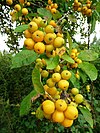Malling series
The Malling series is a group of rootstocks for grafting apple trees. It was developed at the East Malling Research Station of the South-Eastern Agricultural College at Wye in Kent, England. From about 1912, Ronald Hatton and his colleagues rationalised, standardised and catalogued the various rootstocks in use in Europe at the time under names such as Doucin and Paradise.[1][2] Their first list had nine rootstock varieties, assigned the "type" numbers I–IX.[3] The list later grew to twenty-four, and the Roman numerals gave way to Arabic numerals with the prefix "Malling" or "M.".[2][3] From about 1917, collaboration between East Malling and the John Innes Institute, in Merton Park in Surrey, gave rise to the Malling-Merton series, which were resistant to Eriosoma lanigerum, the woolly apple aphid.[2]

References
- ^ A. F. Posnette (2004). Hatton, Sir Ronald George (1886–1965). Oxford Dictionary of National Biography. Oxford: Oxford University Press. doi:10.1093/ref:odnb/33759. (subscription required).
- ^ a b c Lorraine Berkett (2006). Apple Orchard Information for Beginners. The University of Vermont. Archived 10 February 2006.
- ^ a b Tony Webster, Ken Tobutt, Kate Evans (2000). Breeding and Evaluation of New Rootstocks for Apple, Pear and Sweet Cherry. Conference paper, 43rd Annual IDFTA Conference, February 6-9, 2000, Napier, New Zealand. International Dwarf Fruit Tree Association. Accessed September 2017.

